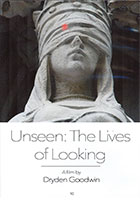
Unseen: The Lives of the Looking 2015
Distributed by Grasshopper Films, 12 East 32nd St., 4th Floor, New York, NY 10016
Produced by Jo Cole and Sarah Caddy
Directed by Dryden Goodwin
DVD, color, 90 min.
College - General Adult
Art, Experimental Film
Date Entered: 05/08/2018
Reviewed by Kimberly Poppiti, Five Towns College, Dix Hills, NYUnseen: The Lives of the Looking is a feature-length film written and directed by multimedia artist, Dryden Goodwin. Using a unique presentational style, the visually-focused film presents viewers with meditations on “looking” at the world. The central question raised by the film comes from Goodwin, who asks: “Where do you start looking?”
Goodwin’s artwork, and the process he follows in creating it, provide a focal point that grounds and ties together other aspects of the film. The footage of him at work is fascinating and allows viewers to observe the development of various images from what at first may seem to be random or unconnected dots and scratches, into detailed and recognizable representations of various subjects. Of his creative process, Goodwin observes: “What you see is very complex and you need to try to capture the essentials […]” This is an apt observation, not only in relation to Goodwin’s work, but also with regard to the film as a whole.
The focus of the film is expanded beyond Goodwin’s creative process to include investigation of the professional perspectives of three other unique individuals: Sir Peng Tee Khaw, an ophthalmic surgeon/professor; Sanjeev Gupta, a “planetary explorer”/professor working with NASA; and Rosa Curling, a human rights lawyer. Although these individuals work in unrelated fields and would not typically be grouped together, they are united here by the critical significance of “looking” to their work. They are introduced independently and their work is then juxtaposed throughout the film.
Each of the individuals featured presents a uniquely compelling argument for the centrality of careful observation. While Goodwin focuses on the commonality created by the intense (and distinctive) particularity with which each “looks” at their work, each subject also clarifies how looking factors into their work, detailing in various degrees the process and goals of their work verbally, while various images from their work are shown. These combine to allow the audience insight into a usually “unseen” perspective or process.
Unseen: The Lives of the Looking is likely to be primarily of interest to artists, and perhaps also to receptive creative minds in other fields. The film challenges viewers to look at the world in new ways without providing explicit instruction on “how to” look. Viewers inspired by the film may be motivated to look at their own practices and creative processes more deeply, and perhaps in new ways.